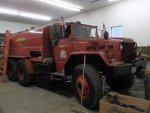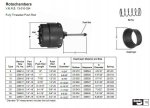FIREFIGHTER
New member
- 20
- 1
- 3
- Location
- Sandown,NH
Hey guys...........long time listener, first time caller!!
My Fire Dept has an M123A1C that was converted to a forestry tanker. I've taken over as maintenance officer, chief wrench turner a few years ago and noticed that the thing didn't stop for crap. The brakes were WAY out of adjustment, a couple of the shoes were fractured. All those issues have since been corrected, but the thing still stops like crap. Since it only goes out a few times a year it really wasn't a priority for them to fix.
I have removed the air lines for the service brakes and done pressure tests. The Front brake lines are getting 50 PSI and the REAR brakes are getting 55 PSI as measured at the air lines disconnected from the cans themselves. According to the Organizational Maintenance Manual TM 9-2320-206-20. 2-175 Brake Application Valve.............connect an accurate pressure gauge in the service line at the rear of the vehicle and open the service cock. The pressure at the rear of the vehicle and open the service line cock. Is the service line the air line going to the service port in the air can?? B.) Depress the Treadle valve to the floorboard. The test gauge should register the same as the pressure gauge on the dash. Assuming the pressure gauge on the dash is accurate, the pressure readings should be the same.
I also read that the differential brake lever on the side of the steering column will only put out 55 PSI so I'm wondering if at some point during the years MAYBE someone connected an air line in the wrong position somewhere underneath. I haven't found any diagrams showing how the air lines are supposed to routed.
So where is the service line at the rear of the vehicle??
I believe I am supposed to be getting 85-105 PSI +/- to brake cans both front and rear. Whatever the air compressor is putting out for pressure. Am I wrong in that assumption??
Might the rods going from the brake pedal to the treadle valve be out of adjustment and not allowing the treadle valve to depress all the way??
Starting to get frustrated.............any help would be appreciated, Thank you!!
My Fire Dept has an M123A1C that was converted to a forestry tanker. I've taken over as maintenance officer, chief wrench turner a few years ago and noticed that the thing didn't stop for crap. The brakes were WAY out of adjustment, a couple of the shoes were fractured. All those issues have since been corrected, but the thing still stops like crap. Since it only goes out a few times a year it really wasn't a priority for them to fix.
I have removed the air lines for the service brakes and done pressure tests. The Front brake lines are getting 50 PSI and the REAR brakes are getting 55 PSI as measured at the air lines disconnected from the cans themselves. According to the Organizational Maintenance Manual TM 9-2320-206-20. 2-175 Brake Application Valve.............connect an accurate pressure gauge in the service line at the rear of the vehicle and open the service cock. The pressure at the rear of the vehicle and open the service line cock. Is the service line the air line going to the service port in the air can?? B.) Depress the Treadle valve to the floorboard. The test gauge should register the same as the pressure gauge on the dash. Assuming the pressure gauge on the dash is accurate, the pressure readings should be the same.
I also read that the differential brake lever on the side of the steering column will only put out 55 PSI so I'm wondering if at some point during the years MAYBE someone connected an air line in the wrong position somewhere underneath. I haven't found any diagrams showing how the air lines are supposed to routed.
So where is the service line at the rear of the vehicle??
I believe I am supposed to be getting 85-105 PSI +/- to brake cans both front and rear. Whatever the air compressor is putting out for pressure. Am I wrong in that assumption??
Might the rods going from the brake pedal to the treadle valve be out of adjustment and not allowing the treadle valve to depress all the way??
Starting to get frustrated.............any help would be appreciated, Thank you!!
Last edited:




